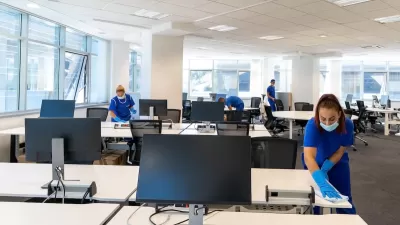While office vacancies remain high and foot traffic sparse in many U.S. downtowns, areas with housing and businesses are more vibrant and desirable than ever.

The rise of remote work during the Covid-19 pandemic has indeed shifted the center of gravity for U.S. cities, but rather than the wholesale ‘death of cities’ predicted early on, this change has simply meant that neighborhoods with mixed-use amenities are thriving while sterile, 9-to-5 business districts flounder.
Konrad Putzier and Kate King outline the phenomenon in The Wall Street Journal, writing, “Many residential neighborhoods benefit from remote work. As people spend more time at home, they frequent local shops, gyms and restaurants, boosting the economy of places such as Brooklyn, N.Y.’s Ditmas Park and Williamsburg, as well as Washington, D.C.’s Georgetown.”
Data shows visitor foot traffic is quickly rebounding to pre-pandemic levels in mixed-use, residential neighborhoods, while downtown foot traffic remains low. “Rent data, meanwhile, attests to strong demand for city living,” with rents significantly higher in desirable neighborhoods. “In the Brentwood neighborhood of Los Angeles, the median rent is up 63%.”
The authors don’t deny the challenges facing cities. “Vacant office buildings leave downtown shops and restaurants with too few customers, while falling commercial building values threaten property-tax revenues,” while “Housing shortages have pushed up rents.” But the neighborhoods with the characteristics and amenities most valued before the pandemic—walkability, access to transit, and a mix of businesses and residential uses—are continuing to draw residents eager to live there.
FULL STORY: American Cities Are Starting to Thrive Again. Just Not Near Office Buildings.

Alabama: Trump Terminates Settlements for Black Communities Harmed By Raw Sewage
Trump deemed the landmark civil rights agreement “illegal DEI and environmental justice policy.”

Planetizen Federal Action Tracker
A weekly monitor of how Trump’s orders and actions are impacting planners and planning in America.

The 120 Year Old Tiny Home Villages That Sheltered San Francisco’s Earthquake Refugees
More than a century ago, San Francisco mobilized to house thousands of residents displaced by the 1906 earthquake. Could their strategy offer a model for the present?

Ken Jennings Launches Transit Web Series
The Jeopardy champ wants you to ride public transit.

BLM To Rescind Public Lands Rule
The change will downgrade conservation, once again putting federal land at risk for mining and other extractive uses.

Indy Neighborhood Group Builds Temporary Multi-Use Path
Community members, aided in part by funding from the city, repurposed a vehicle lane to create a protected bike and pedestrian path for the summer season.
Urban Design for Planners 1: Software Tools
This six-course series explores essential urban design concepts using open source software and equips planners with the tools they need to participate fully in the urban design process.
Planning for Universal Design
Learn the tools for implementing Universal Design in planning regulations.
Clanton & Associates, Inc.
Jessamine County Fiscal Court
Institute for Housing and Urban Development Studies (IHS)
City of Grandview
Harvard GSD Executive Education
Toledo-Lucas County Plan Commissions
Salt Lake City
NYU Wagner Graduate School of Public Service




























